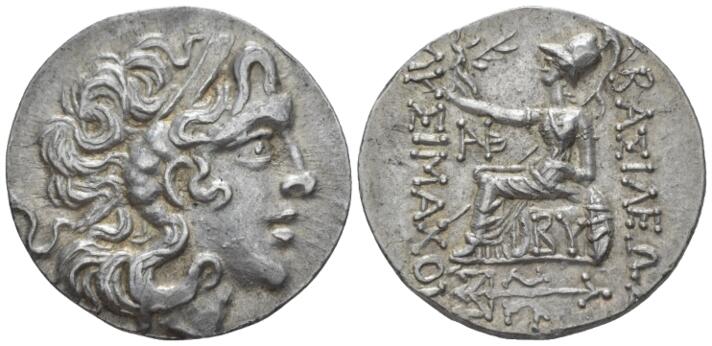Byzantium, silver, tetradrachms (types of Lysimachus) (120-72 BCE)
From SILVER
120 BCE - 72 BCE Silver 107,887 kg
Description
| ObverseInscription or printing placed on the obverse.: | Diademed head of Alexander III r., with horn of Ammon |
| ReverseInscription or printing placed on the reverse.: | ΒΑΣΙΛΕΩΣ ΛΥΣΙMΑΧΟΥ (Greek).Athena seated l. on throne, holding Nike in her outstretched r. hand and spear in her l., below throne, BY and ornamental trident, to l, monogram |
Mint and issuing power
| MintIdentifies the place of manufacture or issue of a numismatic object.: | Byzantium | Ancient regionAncient region.: | Thrace | Modern countryModern country: Turkey | AuthorityIdentifies the issuing power. The authority can be "pretended" when the name or the portrait of X is on the coin but he/she was not the issuing power. It can also be "uncertain" when there is no mention of X on the coin but he/she was the issuing power according to the historical sources: | Lysimachus (Macedonian officer, diadochus and king, c. 360-281 BC) |
Chronology
| FromIdentifies the initial date in a range assigned in a numismatic context. | 120 BCE | toIdentifies the final date in a range assigned in a numismatic context.. | 72 BCE | PeriodTime period of the numismatic object.: Hellenistic 323-30 BC |
Physical description
| MetalThe physical material (usually metal) from which an object is made.: | Silver |
Median weightMedian of the weights of numismatic objects (in grams). in grams | 16.50 | DenominationTerm indicating the value of a numismatic object. Examples: tetradrachm, chalkous, denarius.: | tetradrachm |
StandardStandard.: | Attic |
Image

H74 Byzantium Lysimachus.jpg [1]
References
| Die study referencePublication of the study: | Callataÿ 1997a1Callataÿ 1997a | ||
| Coin series referenceReference to coin series study: | RQEMH2RQEMH, n° 74 | ||
Obverse dies distribution
Reverse dies distribution
no distribution is available
Quantification
| Number of obversesNumber of obverse dies. ᵖ (o) | 177 | Number of singletons (o1)The number of singleton coins. ᵖ | 102 |
| Number of reverse diesNumber of reverse dies. (r) | 273 | Number of coinsNumber of coins. (n) | 315 |
| Coins per obverse dieNumber of coins per obverse die. (n/o) | 1.78 | Coins per reverse dieNumber of coins per reverse die. (n/r) | 1.15 |
| Reverse per obverse ratioRatio of obverse dies divided by reverse dies. (r/o) | 1.54 | Percentage of singletons (o1)number of coins (n) divided by the number of singletons (o1) ᵖ | 57.63 % |
| Original number of dies (O) (Carter 1983 formula)The estimation of the number of coins according to Carter 1983 ᵖ | 326.93 | Coins struck if 20,000 as average productivity per dieCoins made if the average productivity for obverses (according to Carter) is 20,000. ᵖ | 6,538,600 |
| Original number of dies (O) (Esty 2011 formula)The estimation of the number of coins according to the singleton formula in Esty 2011 ᵖ (O) | 404.02 | Survival rate if 20,000 as average productivity per dieSurvival rate if average productivity is 20,000. ᵖ | 0.00005 |
| Coverage (o = % of O) (Esty 1984 formula)Esty 1984 - coverage (% of O) ᵖ (o = % of O) | 67.62% | Die productivity if survival rate 1/2,000Average productivity if survival rate is 1/2,000. ᵖ | 1,927.02 |
| Weight of silver (in kg) if 20,000 coins per die (O = Carter formula)Carter 1983 * Median weight * 20000 (*10 if gold or electrum) ᵖ | 107,887 kg <br /> 107,887 kg | Die productivity if survival rate 1/5,000Average productivity if survival rate is 1/5,000. ᵖ | 4,817.55 |
Remarks
Certainly military